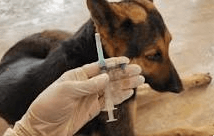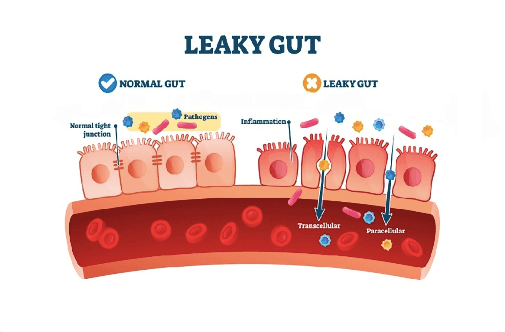The distemper vaccine is not riisk-free. The distemper vaccine is designed to protect your dog from a highly contagious and potentially fatal disease caused by the canine distemper virus (CDV). The virus spreads through direct contact with infected animals through saliva, nasal discharge or feces.
Dogs are not the only ones that can be infected with distemper. Deer, wild boar, foxes, wolves, coyotes, raccoons and skunks can get the disease and spread it. Symptoms of distemper include fever, cough, runny nose and eyes, vomiting, diarrhea, loss of appetite, seizures, neurological problems including paralysis or tremors,
In order to prevent against distemper, the AKC and most vets will recommend administering the distemper vaccine, also called DHPP, DAPP, or DA2PP.
- DHPP: Vaccination against distemper, parvovirus, parainfluenza and hepatitis
- DAPP: Vaccination against distemper, hepatitis, parvovirus and parainfluenza
- DA2PP: Vaccination against distemper, hepatitis, parvovirus and parainfluenza
Typical vaccine guidelines, including the AKC, recommend puppies received the initial distemper vaccine at 6-8 weeks of age followed by boosters every 2-4 weeks until the puppy is 16-20 weeks old. Additional DAP boosters are again recommended at 1 year of age. They suggest that the initial DAP vaccine should be given to puppies when they are 6–8 weeks of age. Boosters are given every 2–4 weeks until the puppy is 16–20 weeks old. An additional DAP booster at 1 year of age also is recommended followed by boosters yearly or every 3 years. However, the distemper vaccine is not risk-free.
According to this 2024 study, 2 litters of puppies were vaccinated with a modified live CDV vaccine. "In litter A, five of ten puppies presented with fever, anorexia, vomiting, and diarrhea a few days post-vaccination. Four puppies died or were euthanized, and autopsy revealed atypical necrosis of the lymphoid tissue. In litter B, two of five puppies developed typical neurological signs some months post-vaccination and autopsy revealed encephalitis. In all cases, affected organs tested positive for CDV on immunohistochemistry, and CDV RNA extracted from the lesions confirmed the presence of vaccine strain. Since multiple puppies from each litter were affected, it cannot be excluded without further studies that some undiagnosed inherited immunodeficiency disorder may have been involved." The distemper vaccine is not risk-free.
I think everyone wants their dog to be protected from every possible threat. And while conventional veterinary medicine tries to offer solutions to diseases like distemper, it doesn't acknowledge that solutions are not one-size-fits all. And unfortunately, constant re-vaccination and sometimes even the initial vaccination could cause more harm than good. The distemper vaccine is not risk-free.
Dogs who are at most risk for contracting distemper are young puppies, under 5 months of age, dogs with underlying conditions and pure-breed dogs. Young puppies and dogs with underlying conditions don't have normal immune function and are more susceptible to disease . Pure-breeds are also susceptible to disease because their genetic lines don't have a lot of diversity, putting them more at risk for disease. If you live in an area that is in the woods, or an area that is known for distemper outbreaks, vaccinating carefully could be your best bet, but remember, the distemper vaccine is not risk-free.
However, the most recent case of distemper took place in Knoxville, Tennessee. in 2022, 1 puppy at the Morristown Hamblen Humane Society (MHHS) showed signs of distemper. The mother and other puppies in the litter were confirmed positive.
I am not anti-vaccine. I am anti-too many vaccines. Unlike the rabies vaccine, distemper is not required by state law, but is recommended. Vaccines are also prescribed on one-dose-fits all basis and does not consider individual metrics like body-weight. All dogs regardless of size, ranging from a 3 lb Yorkie to a 110 lb Saint Bernard get the same amount of vaccine.Vaccine manufacturers are not required to prove that their vaccine is safe in every single breed that that the distemper vaccine is intended for. They aren't required to test to see if that same vaccine is equally safe or not for that 3 lb Yorkie and that110 lb Saint Bernard. Like all vaccines, the distemper vaccine is not risk-free.
When you vaccinate, you must keep in mind that the vaccine includes a version of the pathogen in addition to other ingredients that are used to keep it shelf-life stable: Adjuvants, preservatives, attenuating agents like formaldehyde, growth medium, bovine serum, monkey kidney tissue, porcine tissue, eggs, insect proteins, fungicides and antimicrobials, stabilizers, surfactant permeability enhancer, virus particles and contaminates like glyphosate from GMO-fed animals. You can read more on that here. These ingredients are not natural and can be difficult for the liver, the main detoxification organ in the body to process and metabolize.
If you continue to vaccinate each year or every 6 months, or according to how frequently most vets will recommend, the liver, body literally becomes bombarded and can no longer function optimally, which creates sickness like allergies, autoimmune disease, cancer etc. The dose determines the poison and ultimately, the more toxins in the body, the more sickness.
- Brain Tumors
- Coughing
- Conjunctivitis
- Diarrhea
- Emaciation
- Epilepsy
- Eruptions around the mouth
- Eye and nose discharge
- GI Lymphoma
- Inflammatory Bowel Disease
- Loss of appetite
- Paralysis
- Pneumonia
- Seizures
- Skin eruptions
- Spasms
- Swelling of feet with red foot pads
- Vomiting
- Water feces with blood, mucous and or foul odor
If your dog presents any of these symptoms after receiving the distemper vaccine, it is very likely they are suffering from vaccinosis, a vaccine reaction..
Deciding to vaccinate against distemper is a serious decision. Do the risks of acute or chronic adverse reaction symptoms outweigh the risk of maybe your dog getting distemper?
If you do decide to vaccinate, and your dog has received their initial vaccination, it is probably they have lifelong immunity and you should keep in mind that boosters are probably not necessary after core vaccines are administered. According to prominent immunologists, Dr. Ronald Schultz, PhD as published in Dogs Naturally Magazine, "Immunological memory provides durations of immunity for core infectious diseases that far exceed the traditional recommendations for annual vaccination," which is " supported by a growing body of veterinary information and well-developed epidemiological vigilance in human medicine that indicates immunity induced by vaccination is extremely long lasting and, in most cases, lifelong.” Once that initial vaccine is administered, always, always request a titer blood test to determine immunity before administering a vaccine your dog probably does not need.
The best defense against disease and vaccine reactions is a good offense. That means keeping your dog healthy naturally, by feeding a high-quality diet, providing ample opportunities to exercise and vaccinating very carefully.
Donate to Bobzilla.org

$5.00
The veterinary business is business which is not in the business of curing your animal, but Bobzilla's business is. Bobzilla is committed to one hundred percent transparency in all of its scientific research into animal wellness and prevention of disease and one… read more




